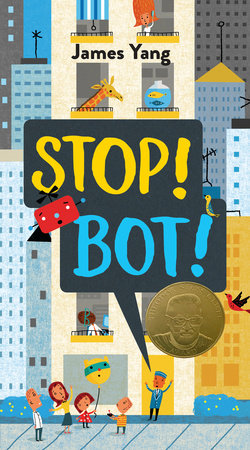 |
| Photo courtesy of Ann Schwab |
Ann Schwab is a Senior Librarian with Denver Public Library where she manages the Central Children’s Library. She currently leads the library’s Grade Level Reading project team and is excited to explore new ways to support children in K – 3rd grade (and the adults in their lives!) as they learn to read.
Sometimes I page through a new book and say to myself, “This looks pretty good.” I read it with award criteria in mind and think, “Actually, this is really good.” My excitement builds, “This could be a contender!” I flip to the author and illustrator bios and there’s that familiar sinking feeling. It’s a no go. Ineligible. The author or illustrator (or both!) live in another country and the award is “restricted to author(s) and illustrator(s) who are citizens or residents of the United States”. Or I discover the book has been translated and “books originally published in other countries are not eligible.” While not eligible for the Geisel, many are excellent examples of other aspects of the criteria and contribute to “the body of children’s literature that encourages and supports the beginning reader".
It’s time to celebrate these books and not let them get lost in the flurry of end-of-year mock excitement! Here are seven titles with an international connection published in the US in 2019. I’ve included publisher, translator and author/illustrator country of residence to the best of my knowledge. Be sure to share your favorite Geisel-worthy international titles from this year in the comments!
 |
| Cover of Jump! by Tatsuhide Matsuoka |
 |
Cover of Poppy & Sam and the
Mole Mystery by Cathon |
 |
| Cover of The Clothesline by Orbie |
Jump! by Tatsuhide Matsuoka, illustrated by the author (published by Gecko, translated from the Japanese by Cathy Hirano, author lives in Japan)
A board book masquerading as a beginning reader? A beginning reader masquerading as a board book? In the end it doesn’t matter because this gem is full of engaging illustrations, action, and humor. The vertical design may be a challenge for some, but the simple sentences and repeating text help make this an accessible book for new readers.
Poppy & Sam and the Mole Mystery by Cathon, illustrated by the author (published by Owlkids, translated from the French by Susan Ouriou, author lives in Canada)
Young Poppy and her panda pal Sam are back for more detective teamwork in this follow-up to 2018’s Poppy & Sam and The Leaf Thief. This tale of friendship and discovery contains short sentences in speech bubbles with ample white space around the text making this a satisfying graphic novel/picture book hybrid for new readers.
The Clothesline by Orbie, illustrated by the author (published by Owlkids, translated from the French by Karen Li, author lives in Canada)
Reggie has a ritual when he races down the stairs. He likes to yank the clothesline knot and hear the satisfying sound it makes when he releases it. One day he slips in the midst of this ritual yank and finds himself whizzing down the clothesline only to get stuck dangling above the backyard. With straightforward text and watercolor illustrations full of drama and suspense, the plot clearly “advances from one page to the next and creates a ‘page-turning’ dynamic”.
 |
Cover of Hats Are Not for Cats!
by Jacqueline K. Rayner |
 |
Cover of Tip and Tucker:
Road Trip by Ann Ingalls
and Sue Lowell Gallion,
illustrated by André Ceolin |
 |
Cover of Soccerverse: Poems
About Soccer by Elizabeth
Steinglass, illustrated by Edson Ikê |
Hats Are Not for Cats! by Jacqueline K. Rayner, illustrated by the author (published by Clarion, author lives in the UK) “Hats are not for cats!” decries a pompous canine in this humorous tale while a fun loving, friendly feline sets out to prove otherwise. Simple, rhyming text with lots of repetition, along with expressive illustrations, make this picture book also work well as a beginning reader.
Tip and Tucker: Road Trip by Ann Ingalls and Sue Lowell Gallion, illustrated by André Ceolin
Tip and Tucker: Hide and Squeak by Ann Ingalls and Sue Lowell Gallion, illustrated by André Ceolin (published by Sleeping Bear, illustrator lives in Brazil)
Hamsters Tip and Tucker are the stars of this new entry in Sleeping Bear’s leveled reading series “I Am a Reader!”. Specifically targeted to grades K-1, the series follows the adventures of the hamster duo in teacher Mr. Lopez’s classroom. Italicized text highlights occasional words and phrases in Spanish which may be a welcome addition or stumbling block for readers depending on their background knowledge.
Soccerverse: Poems About Soccer by Elizabeth Steinglass, illustrated by Edson Ikê (published by Wordsong, illustrator lives in Brazil)
In 22 poems in a variety of forms, this book celebrates all things soccer, from equipment to dealing with bullies and ball hogs. The reverso poems “Instructions to Field Players” and “Instructions to the Goalkeeper” gives readers a chance to read the same text twice in a unique way. The poems span the K - 2nd grade reading continuum with some featuring short sentences and words while others contain longer sentences with more advanced vocabulary. The subject matter and imaginative illustrations, however, are sure to motivate many readers and their background knowledge of the game may buoy them through the challenging text.
 |
Cover of Beneath the Bed and
Other Scary Stories by Max
Brallier, illustrated by
Letizia Rubegni |
Beneath the Bed and Other Scary Stories by Max Brallier, illustrated by Letizia Rubegni (published by Scholastic, illustrator lives in Italy)
A collection of scary stories wrapped in an early chapter book package, this title hits the “subject matter must be intriguing enough to motivate the child to read” criteria sweet spot. Rubegni’s detailed, Edward Gorey-esque illustrations reinforce details of the stories. While this title hovers at the upper end of the Geisel target audience, it does so with confident creepiness and flair.

















